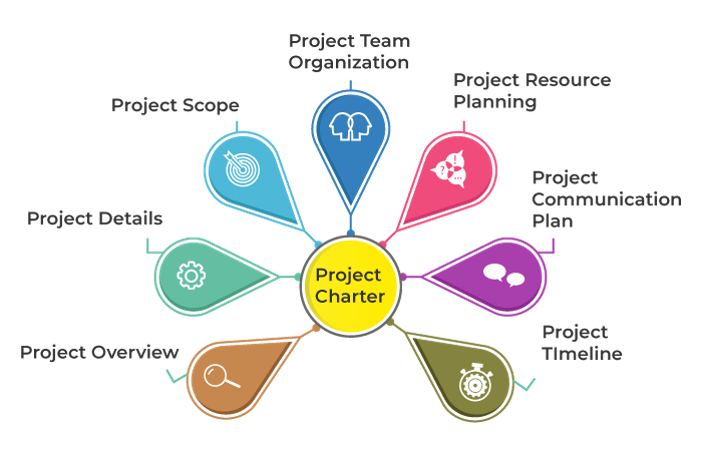
Project Charter is one of the first critical steps in the project life cycle. Without a project charter, a project is like a ship without sails; it doesn’t have what it takes to move forward and lacks direction. According to popular project management certification courses approaches, the primary objective is to develop a project charter before initiating a project.
The main purpose of developing a project charter is to identify the project vision, scope, deliverables, execution, and organization, and implementation plan. It gives direction to the project and helps you to get the buy-in from all the stakeholders on how the project life cycle spans out. The project charter will also help you to manage the scope of your project wherein it determines what needs to be attained at what point in time.
Critical Steps Involved in Developing a Robust Project Charter
-
Have a Good Measure of Project Vision:
The first and foremost step in creating a project charter is to have a good measure of your project vision. The vision states the purpose of the project and gives a fixed goal to attain to the project team. Develop SMART goals along with your vision; this happens when the project objectives are clear from the beginning. Your project goals should be specific, measurable, attainable, real, and time-bound (SMART). Once you have documented the vision and the objectives for the project, now you have to define the scope and document the same. The project scope management identifies how the business environment will change during project deliverables.
-
Defining Project Structure:
This whole activity helps to identify clients, stakeholders, assigning responsibilities, and creating reporting lines. A client is a person or an entity responsible for agreeing to project deliverables and signing of the project to start in the first place. A stakeholder can be a person or an entity depending on the specific interest in the project. A stakeholder is someone who is directly involved in the project in the form of the project owner, team members, project manager, project sponsor, internal to the organization such as a Financial Head or CEO to ensure the project has enough resources and to oversee the project lifecycle or in the form of external entities in project consultants or governmental departments.
Now assign responsibilities by making a list where every key role is involved in a project. It can be project owner, project sponsor, Change Advisory Board (CAB) or project manager. It will be even more helpful if you provide a short summary regarding the responsibility of each member.
After completing the documentation of project structure in the organization, you can create a diagram with project stakeholders and the reporting lines between them using a project organization chart.
-
Describing Project implementation:
After the vision and creating project structure you should now be in a position to describe the project implementation. The project implementation should include key milestones, implementation plan, dependencies and resource plan. Here the implementation plan will include all the steps and activities of the project along with the phases of the project. This in fact gives the stakeholders the confidence that the project has been well thought out. Creating a resource plan should be the next step for the project; this should include all resources such as people, finance, materials, and equipment.
-
Listing Project Risks:
This is the final step in the project charter where you have to document the risks and issues that might arise down the line in your project. With this activity, you will be better prepared for the risks and you will have a plan B if something goes wrong.
How to Develop A Project Charter?
Before even thinking about how to create a Project Charter, one should always start preparing a Project Statement of Work (A written description of the project’s product, service, or result) and a business Case (Reason for undertaking the project, Solutions to resolve problems, and analysis of the benefit-cost. These factors will work as a baseline for the Project Manager to draft the Project Charter.
A legal authorization document that states the beginning of a project, while describing the purpose and scope of a project is called a Project Charter. As formal documentation, any given project nowadays requires a signed project charter before initiating a new project. For example, if a stakeholder needs to know what he is investing in, the project charter will provide him/her with precise details as to what the project is about and the resources required for the successful completion of the project.
The project charter is an essential part of project management due to its importance as a legally binding document. It provides clarifications on the general specification, the purpose of the project, the key stakeholders, and the possible outcomes. The critical thing to be noted is that, upon completing the project charter, there is no room (in rare cases) for any further changes.
Expert Opinions about Developing a Project Charter
“Do not underestimate the value of the project charter. It is such an important document that a project should not be started without one. If the project charter serves as a definition of how success will be measured, then without a project charter, the project and project manager cannot be successful”. – Rita Mulcahy
“Take great pride and care in your project charter because this is where you sow the good seeds. It will eventually take care of you.” – Randy Tangco – PMP Expert
Is creating a Project Charter that important?
As discussed earlier, the primary purpose of a project charter is to authorize the project manager to start the approved project and allow him to use organizational resources to accomplish the objectives of the project. A perfect project charter will help executives see the business value of the project and also provide them with information on how well the project is aligned with the organizational strategies.
Josh Nankivel, PMP®, a trainer, and principal of PMStudent, was quoted saying that “A project charter should also serve as an executive overview of your project, one that any new executive can reference to evaluate it. A good project charter can help save you from unnecessary scrutiny or having your project shut down because some executive didn’t see the business value in it from their perspective”.
Cornelius Fichtner, PMP® trainer and host of the PM Podcast, views whether should a Project Manager be involved in creating a Project Charter – “The PM is a subject matter expert when it comes to initiating and starting a project. Hence the PM is more qualified to create the project charter. He or she has more experience in doing this and knows what kind of details to add to the project charter”.
Formal Components of a Project Charter
Project Charter ITTOs – Inputs
Business Documents
The sources that depict the information about the project’s objectives and their business goals are the business case and the benefits management plan. Even though the business documents are developed before the project initiation, they are reviewed periodically.
Agreements
Agreements are those documents that are used to define the underlying intentions of a project. Agreements can take various forms contracts, service level agreements (SLA), memorandums of understanding (MOUs), letters of intent and agreement, emails, verbal agreements, or other written agreements. In simple terms, it’s a contract that is used when a project is being performed for an external customer or client.
Enterprise Environmental Factors
Understanding all policies, practices, procedures, and legislation that prevail both on the inside and outside of the company will impact the way a project is managed.
| Internal Factors | External Factors |
|---|---|
| Organizational Structure | Government Regulations |
| Organization’s Culture | Market Conditions |
| Working Style | Political Situations |
| Organization Policies | Weather Conditions |
| Reviews and training records | Infrastructure |
Organizational Process Assets
The plans, processes, policies, procedures, and knowledge bases are specific to and used by the performing organization.
| Knowledge Base | Procedures / Processes / Policies |
|---|---|
| Lessons Learned | Project lifestyle |
| Project Files | Organization Process Documents |
| Financial Database | Communication Management |
| Project Management Database | Guidelines |
| Previous Projects Database | Policies |
Project Charter ITTOs – Tools And Techniques
Expert Judgment
A crucial step in executing the project by taking opinions from subject matter experts, garnering valuable inputs, and understanding the business case complexity related to the project. The subject matter experts as mentioned above should have the desired skills and specialized knowledge on the following topics:
-
-
Organizational strategy
-
Benefits management
-
Technical knowledge of the industry
-
Focus area of the project
-
Duration and budget estimation, and
-
Risk identification
-
Data Gathering
Listed below are some of the techniques that can be used for gathering data:
-
-
Brainstorming – This is a method that is used to collect vast and unique data in a short period. The project team members discuss and generate new ideas that can contribute to the project’s success. The brainstorming technique helps in two ways, namely – Generating Ideas and Analyzing Ideas. Ideas or solutions can be gathered from the project stakeholders, subject matter experts, or the project manager during the development of the project charter.
-
Focus Groups – This is a technique that is used to bring together stakeholders and subject matter experts to learn about the recognized project risk, success criteria, and other topics in a more conversational way than a one-on-one interview.
-
Interviews – As the role of the stakeholders is considered crucial in determining the success of the project, talking to them throughout the project’s lifecycle is essential. This technique will provide the project manager with information on high-level requirements, constraints or assumptions, project approvals, and many other things.
-
Interpersonal and Team Skills
The crucial techniques involved in this process are as follows
-
-
Conflict management – The project’s success depends on the approval of the stakeholders. They are the ones who determine the project’s objectives, requirements, project description, milestones, and all other essential elements of the project charter. Hence it is best advised that the stakeholders are appropriately aligned with the project, and the conflict management technique is what best suits a project manager.
-
Facilitation – it’s a technique that can efficiently drive a team to form a successful decision or solution. It ensures that there is active participation, mutual understanding, and contributions, from every individual. The important thing is that everyone should be given an equal opportunity in expressing themselves and their ideas or suggestions are not to be left unattended too.
-
Meeting Management – Meeting management is a technique that includes preparing the meeting agenda, inviting key stakeholders representatives, discussing the project outcomes, and most importantly preparing and sending out minutes of meeting data.
-
Meetings
This process comprises meetings that are held with key stakeholders to identify the project objectives, success criteria, key deliverables, high-level requirements, summary milestones, and other summary information.
Project Charter ITTOs – Outputs
Project Charter
The final output of all the features mentioned above will result in creating an entirely accessible project charter. This final project charter will act as an essence that can be used during the project. The project charter documents the high-level information on the project and on the product, service, or result in which the project is intended to meet, like:
-
-
Project purpose
-
High-level requirements
-
Overall project risk
-
Preapproved financial resources
-
Summary milestone schedule
-
Measurable project objectives
-
Key stakeholder list
-
Assigned project manager
-
Project Manager’s responsibility and authority level.
-
Assumption Log
The business case will identify the high-level strategic and operational assumptions even before the project is initiated and will be added to the project charter. Task assumptions such as defining technical specifications, schedules, estimates, risks, etc. are generated at the lower level of the project. Basically, the assumption log will record all the expectations and project pressures throughout the project’s lifecycle.
Conclusion
A project charter is not merely a document that states facts and information concerning a project. It serves as the groundwork for efficiently communicating with stakeholders and for efficiently routing work between various individuals that take part in the project. Do note that having a good and complete Project Charter is the very first step in managing a project.
Know more about project management best practices through Invensis Learning’s Project Management certification training on PMP Certification Online, CAPM Training and Certification, Prince2 Foundation and Practitioner Course Online, Project Management Fundamentals, P3O, and MSP. We are a trusted training partner for Fortune 500 companies and Government institutions globally.


















